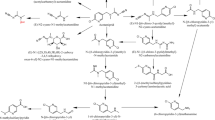Abstract
The effect of a usually lethal dose of 2,3,7,8-tetrachlorodibenzo-p-dioxin (TCDD; 125 μg/kg) was studied on the conversion of14C-alanine into14C-glucose in male Sprague-Dawley rats by established procedures (determination of plasma alanine and blood glucose by enzymatic assays and isolation of14C-alanine and14C-glucose from whole blood by column chromatography). TCDD-treated rats converted significantly (p < 0.05) less14C-alanine into14C-glucose than did their pair-fed or ad libitum-fed counterparts, indicating reduced gluconeogenesis as a result of TCDD treatment. This finding suggests that reduced gluconeogenesis in TCDD-treated rats contributed to the progressively developing, severe hypoglycemia observed in these animals. Corticosterone, a key hormone in gluconeogenesis, provides partial protection from TCDD-induced toxicity in hypophysectomized rats. Therefore, the conversion of14C-alanine into14C-glucose was also determined in hypophysectomized rats dosed with TCDD (125 μg/kg) and given corticosterone (25 μg/ ml in drinking water). These rats also converted significantly (p <0.05) less14C-alanine into14C-glucose than did their pair-fed counterparts. However, in contrast to non-hypophysectomized TCDD-treated rats, these rats maintained marginal normoglycemia even at 64 days after dosing with TCDD, which suggests that the partial protective effect of corticosterone in hypophysectomized, TCDD-treated rats is unrelated to its effect on gluconeogenesis. The protection provided by corticosterone supplementation in TCDD toxicity is more likely due to reduced peripheral utilization of glucose enabling the animals to maintain marginal normoglycemia.
Similar content being viewed by others
References
Balk JL, Piper WN (1984) Altered blood levels of corticosteroids in the rat after exposure to 2,3,7,8-tetrachlorodibenzo-p-dioxin. Biochem Pharmacol 33: 2531–2534
Baxter JD, Forsham PH (1972) Tissue effect of glucocorticoids. Am JMed 53: 573–589
Christian BJ, Menahan LA, Peterson RE (1986) Intermediary metabolism of the mature rat following 2,3,7,8-tetrachlorodibenzo-p-dioxin treatment. Toxicol Appl Pharmacol 83: 360–378
Exton JH, Park CR (1967) Control of gluconeogenesis in the liver. I. General features of gluconeogenesis in the perfused liver of rats. J Biol Chem 242: 2622–2636
Gasiewicz TA, Holscher MA, Neal RA (1980) The effect of total parenteral nutrition on the toxicity of 2,3,7,8-tetrachlorodibenzo-p-dioxin in the rat. Toxicol Appl Pharmacol 54: 469–488
Gorski JR, Rozman K (1987) Dose-response and time course of hypothyroxinemia and hypoinsulinemia and characterization of insulin hypersensitivity in 2,3,7,8-tetrachlorodibenzo-p-dioxin (TCDD)-treated rats. Toxicology 44: 297–307
Gorski JR, Rozman T, Greim H, Rozman K (1988a) Corticosterone modulates acute toxicity of 2,3,7,8-tetrachlorodibenzop-dioxin (TCDD) in male Sprague-Dawley rats. Fund Appl Toxicol 11: 494–502
Gorski JR, Lebofsky M, Rozman K (1988b) Corticosterone decreases toxicity of 2,3,7,8-tetrachlorodibenzo-p-dioxin (TCDD) in hypophysectomized rats. J Toxicol Environ Health 25: 349–360
Gorski JR, Weber LWD, Rozman K (1988c) Tissue-specific alterations of de novo fatty acid synthesis in 2,3,7,8-tetrachlorodibenzo-p-dioxin (TCDD)-treated rats. Arch Toxicol 62: 146–151
Gorski JR, Muzi G, Weber LWD, Pereira DW, Iatropoulos MJ, Rozman K (1988d) Elevated plasma corticosterone levels and histopathology of the adrenals and thymuses in 2,3,7,8-tetrachlorodibenzo-p-dioxin (TCDD)-treated rats. Toxicology 53: 19–32
Hsia MTS, Kreamer BL (1985) Delayed wasting syndrome and alterations of liver gluconeogenic enzymes in rats exposed to the TCDD congener 3,3',4,4'-tetrachloroazoxybenzene. Toxicol Lett 25: 247–258
Lenzen S, Bailey CS (1984) Thyroid hormones, gonadal and adrenocortical steroids and the function of the islets of Langerhans. Endocrine Rev 5: 411–589
Muzi G, Gorski JR, Rozman K (1989) Mode of metabolism is altered in 2,3,7,8-tetrachlorodibenzo-p-dioxin (TCDD)-treated rats. Toxicol Lett 47: 77–86.
Potter CL, Sipes IG, Russell DH (1983) Hypothyroxinemia and hypothermia in response to 2,3,7,8-tetrachlorodibenzo-p-dioxin administration. Toxicol Appl Pharmacol 69: 89–95
Potter CL, Menahan LA, Peterson RE (1986) Relationship in alterations in energy metabolism to hypophagia in rats treated with 2,3,7,8-tetrachlorodibenzo-p-dioxin. Fund Appl Toxicol 6: 89–97
Reilly PEB (1975) Determination of14C-labeled plasma L+α-alanine specific radioactivity. Anal Biochem 65: 298–304
Rozman K, Pereira DW, Iatropoulos MJ (1986) Histopathology of interscapular brown adipose tissue, thyroid, and pancreas in 2,3,7,8-tetrachlorodibenzo-p-dioxin (TCDD)-treated rats. Toxicol Appl Pharmacol 82: 551–559
Snedecor G, Cochran N (1980) Statistical Methods, 7th ed. Iowa State University Press, Ames, IA
Weber LWD, Greim H, Rozman K (1987) Metabolism and distribution of14C-glucose in rats treated with 2,3,7,8-tetrachlorodibenzo-p-dioxin (TCDD). J Toxicol Environ Health 22: 195–206
Wilkinson CW, Engeland WC, Shinsako J, Dallman MF (1981) Non-steroidal adrenal feedback demarcates two types of pathways to CRF-ACTH release. Am J Physiol 240: E136-E145
Williamson DH (1974) L-Alanine: determination with alanine dehydrogenase. In: Bergmeyer HU (ed) Methods in enzymatic analysis. Academic Press, New York, NY, pp 1679–1682
Zinkl JG, Vos JG, Moore JA, Gupta BN (1973) Hematologic and clinical chemistry effects of 2,3,7,8-tetrachlorodibenzo-p-dioxin in laboratory animals. Environ Health Perspect exp. 5: 111–118
Zorzano A, Herrera E (1984) Liver and kidney cortex gluconeogenesis from L-alanine in fed and starved rats. Eur J Biochem 16: 263–267
Author information
Authors and Affiliations
Rights and permissions
About this article
Cite this article
Gorski, J.R., Weber, L.W.D. & Rozman, K. Reduced gluconeogenesis in 2,3,7,8-tetrachlorodibenzo-p-dioxin (TCDD)-treated rats. Arch Toxicol 64, 66–71 (1990). https://doi.org/10.1007/BF01973379
Received:
Revised:
Accepted:
Issue Date:
DOI: https://doi.org/10.1007/BF01973379




